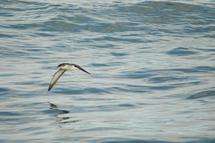Seabird research tracks ocean health

Oxford University scientists hope to uncover the secret life of an important British seabird using technology developed with Microsoft Research Cambridge.
The Manx Shearwater is a species that travels thousands of kilometres over the sea in search of food and only returns to land at night, making traditional field observation difficult. Yet monitoring wild seabird populations is increasingly important as they are particularly sensitive to environmental change and give an indication of the health of our oceans.
‘Manx Shearwaters spend the day at sea, only coming on land after nightfall for fear of predators,’ said Professor Tim Guilford of Oxford University’s Department of Zoology. ‘They nest in underground burrows on remote islands or high up on mountaintops. The challenge for us has been to develop methods that can shed light on their lives at sea and technology that can track a 400-gram diving seabird.’
As part of the research tiny radio-frequency identification (RFID) tags are being attached to 50 breeding pairs of Manx Shearwaters from Skomer Island, Wales, and sophisticated wireless sensors are being embedded in their burrows. The RFID tags and sensors monitor the birds’ activities, as well as temperature, pressure, movement and weight in real-time, while tiny GPS trackers developed at Oxford University map the birds’ long foraging trips.
Early results using the GPS trackers suggest that the birds, that were thought to patrol the fishing grounds of the Bay of Biscay, may have already been forced to move northwards in search of food as sea temperatures have risen. Professor Guilford commented: ‘There may be another explanation for this but it is clearly vital that we understand how their foraging movements respond to environmental variables, particularly from the perspective of understanding this remarkable species’ vulnerability to change.’
The new technology enables scientists to access and analyse vital information about wild animal populations in real-time from anywhere in the world using handheld/mobile devices. Powered by solar panels and making use of wireless, satellite and mobile phone networks, the system is designed specifically for research at remote locations over long periods.
‘The importance of this system is its ability to monitor animals autonomously over greater distances and more frequently and consistently than previously possible,’ said Robin Freeman, one of the scientists leading the project at Microsoft Research Cambridge. ‘Gathering this kind of data about the Manx Shearwater will provide insights into seabirds’ changing behaviour in light of climate change.’
‘This initiative is focused on developing a new generation of computational tools to tackle fundamental challenges in science,’ said Professor Stephen Emmott, Director of the Science Initiative at Microsoft Research. ‘Our aim is to accelerate the ability of scientists worldwide to make significant advances in areas of science where crucially important scientific and societal challenges exist, such as environmental change and its impact.’
This research is a collaboration between the University of Oxford, Microsoft Research Cambridge and Freie Universität, Berlin.
Source: Oxford University















